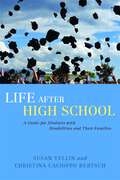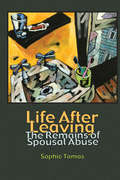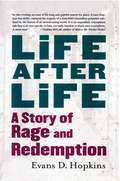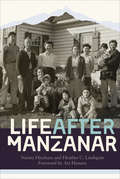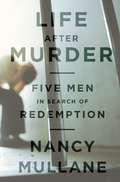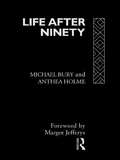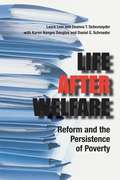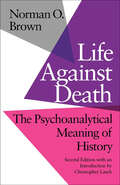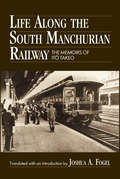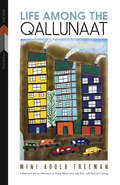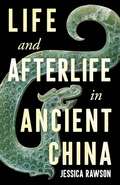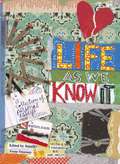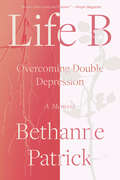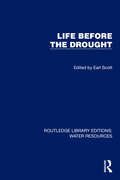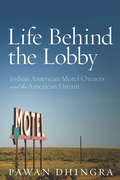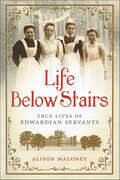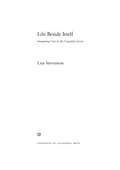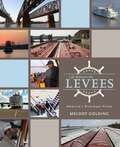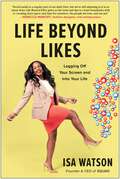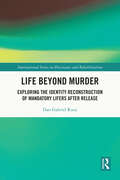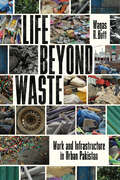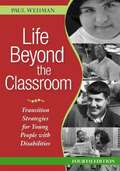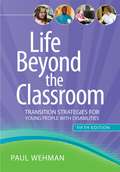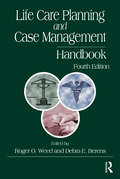- Table View
- List View
Life After High School: A Guide for Students with Disabilities and Their Families
by Susan Yellin Christina Cacioppo Bertsch*Bronze Medal Winner in the Education / Academic / Teaching Category of the 2011 IPPY Awards** Bronze Medal Winner in the 2010 BOTYA Awards Education Category *Graduating high school and moving on to further education or the workplace brings with it a whole new set of challenges, and this is especially true for students with disabilities. This useful book provides a complete overview of the issues such students and their families will need to consider, and outlines the key skills they will need in order to succeed once they get there. The authors describe the legal landscape as it applies to students with disabilities in the USA, and how to obtain the proper disability documentation to ensure that the student receives the right support and accommodations in college. Focusing specifically on the issues that affect students with disabilities, they offer advice on everything from dealing with college entrance exams and the college application process, to selecting the right college, visiting the campus, and achieving medical and financial independence away from home. A list of further resources guides students and their families towards additional sources of information and support, and stories of students with disabilities who have made the transition from high school to further education or the workplace are included throughout. This accessible and thoroughly readable book offers help and support to students with disabilities of all kinds, and their families, both before and during the transition to life after high school.
Life After Leaving: The Remains of Spousal Abuse (Writing Lives: Ethnographic and Autoethnographic Narratives #11)
by Sophie TamasAfter leaving her twelve-year marriage, Sophie Tamas went to the local women's shelter to ask if she had been abused. The result is Life after Leaving, a performative, arts-based journey into the aftermath of spousal abuse and the endless struggle to make sense of loss. We see Sophie's world—the academic lectures, the therapy sessions, the childrearing, the dealings with an ex-spouse, the house reconstruction—as she looks for answers in the literature and in the lives of other women. Both lyrical and theoretical, autoethnographic and analytical, her captivating story builds to a chorus of voices, as her study participants express the loving, longing, pain, hope, and frustration of their experiences after leaving abusive relationships. The text closes with insightful and surprising suggestions for reframing "recovery". An earlier version of this manuscript was short-listed for the AERA Arts-Based Dissertation Award and won the 2011 Outstanding Dissertation Award from the International Institute for Qualitative Methodology. Sponsored by the International Institute for Qualitative Methodology, University of Alberta.
Life After Life: A Story of Rage and Redemption
by Evans D. HopkinsLife After Life is the haunting and gloriously redemptive tale of Evans D. Hopkins's many lives, a sweeping journey from promising middle-class youth to civil rights militant, from criminal and convict to celebrated writer and enlightened man. Evans D. Hopkins was born during the Jim Crow era in a second-rate, segregated hospital, and educated in segregated primary schools in Danville, Virginia, a town that proudly proclaimed itself the "Last Capital of the Confederacy." With parents who stressed the value of education, as a teenager he was in the forefront of desegregation and the Civil Rights Movement. At the same time, he fell in love with the traditionally white man's game of tennis, modeling himself after his idol, the legendary Arthur Ashe, only to be swept off the courts by the Black Panther Party at the age of sixteen. Just out of high school, Hopkins moved to Panther headquarters in Oakland, California, where he spent two years writing for the Party newspaper, covering the trial of the San Quentin Six, working with Party founders Huey Newton and Bobby Seale, and taking part in their move into politics when Seale ran for mayor of Oakland. He became historian for the group, documenting the years when altercations with authorities resulted in the deaths of numerous Panthers. And he was witness to the internal strife within the Party that led to the group's decline and his own decision to leave in the fall of 1974. When he returned to Danville, Hopkins was a different man, disillusioned and filled with rage and a legacy of militancy. He was, in his own words, "the quintessential angry young black man." Convicted of armed robbery and given a life sentence, Hopkins would spend twenty of the next twenty-two years in the prisons of Virginia. Inside, fighting despair and isolation and dreaming of escape, Hopkins sought salvation in the written word, writing in his cell in the early morning hours to escape the noise of the prison. Focusing on issues of social and criminal injustice, Hopkins would begin reaching a national audience when his inside account of an execution, "Who's Afraid of Virginia's Chair," was published in The Washington Post. Paroled in 1997, Hopkins returned home, a free man at last, but facing the overwhelming challenges of caring for his aging parents and daily life in a world that was new after so many years of incarceration. In this stunning look back at a man's struggle with himself and the world around him, Life After Life is also about the influences that sustained Hopkins's development despite overwhelming odds, influences that allowed him to emerge from two decades of imprisonment an uncorrupted man, still able to give to his family and community. Finally, Life After Life is a searingly honest view of events in America in the second half of the 20th century as seen through the eyes of a child, a militant, a prisoner, and, most important, a writer.
Life After Manzanar
by Naomi Hirahara Heather C. Lindquist&“A compelling account of the lives of Japanese and Japanese Americans incarcerated during World War II . . . instructive and moving.&”—Nippon.com From the editor of the award-winning Children of Manzanar, Heather C. Lindquist, and Edgar Award winner Naomi Hirahara comes a nuanced account of the &“Resettlement&”: the relatively unexamined period when ordinary people of Japanese ancestry, having been unjustly imprisoned during World War II, were finally released from custody. Given twenty-five dollars and a one-way bus ticket to make a new life, some ventured east to Denver and Chicago to start over, while others returned to Southern California only to face discrimination and an alarming scarcity of housing and jobs. Hirahara and Lindquist weave new and archival oral histories into an engaging narrative that illuminates the lives of former internees in the postwar era, both in struggle and unlikely triumph. Readers will appreciate the painstaking efforts that rebuilding required and will feel inspired by the activism that led to redress and restitution—and that built a community that even now speaks out against other racist agendas. &“Through this thoughtful story, we see how the harsh realities of the incarceration experience follow real lives, and how Manzanar will sway generations to come. When you finish the last chapter you will demand to read more.&”—Gary Mayeda, national president of the Japanese American Citizens League &“An engaging, well-written telling of how former Manzanar detainees played key roles in remembering and righting the wrong of the World War II incarceration.&”—Tom Ikeda, executive director of Densho
Life After Murder: Five Men in Search of Redemption
by Nancy MullaneOnce a murderer, always a murderer? Or can a murderer be redeemed? Who do they really become after they have served decades in prison? What does it take for a killer to be accepted back into society? What is the chance that he will kill again? Award-winning journalist Nancy Mullane found herself facing these questions when she accepted an assignment to report on the exploding costs of incarceration. But the men she met behind the walls astonished her with their remorse, introspection, determination, and unshakable hope for freedom and forgiveness. Life After Murder is an intimately reported, utterly compelling story of five convicted murderers sentenced to life with the possibility of parole, who discover after decades in prison that their second chance, if it comes at all, is also the challenge of a lifetime. It follows their struggle for redemption, their legal battles to make good on the state’s promise of parole, and the lives they found after so many years inside.
Life After Ninety
by Michael Bury Anthea HolmeIn Life After Ninety Micheal Bury and Anthea Holme have surveyed and interviewed 200 individuals, living at home and in institutions, to examine old age stereotypes and present a unique picture of the health, quality of life, and social circumstances of the very old. Longevity and the factors which promote it are also discussed, and throughout the book the concept of the 'life course' is employed, which brings together the biographical experiences of individuals, and the changing historical circumstances of the twentieth century, through which they have lived.
Life After Welfare
by Laura Lein Deanna T. SchexnayderIn the decade since President Clinton signed the Personal Responsibility and Work Opportunity Reconciliation Act of 1996 into law--amidst promises that it would "end welfare as we know it"--have the reforms ending entitlements and moving toward time limits and work requirements lifted Texas families once living on welfare out of poverty, or merely stricken their names from the administrative rolls?Under welfare reform, Texas has continued with low monthly payments and demanding eligibility criteria. Many families who could receive welfare in other states do not qualify in Texas, and virtually any part-time job makes a family ineligible. In Texas, most families who leave welfare remain in or near poverty, and many are likely to return to the welfare rolls in the future. This compelling work, which follows 179 families after leaving welfare, is set against a backdrop of multiple types of data and econometric modeling. The authors' multi-method approach draws on administrative data from nine programs serving low-income families and a statewide survey of families who have left welfare. Survey data on health problems, transportation needs, and child-care issues shed light on the patterns of employment and welfare use seen in the administrative data. In their lives after welfare, the families chronicled here experience poverty even when employed; a multiplicity of barriers to employment that work to exacerbate one another; and a failing safety net of basic human services as they attempt to sustain low-wage employment.
Life Against Death: The Psychoanalytical Meaning of History
by Norman O. BrownA shocking and extreme interpretation of culture, history, and the father of psychoanalysis. In Life Against Death: The Psychoanalytical Meaning of History, social philosopher Norman O. Brown radically analyzes and critiques the work of Sigmund Freud. Brown attempts to define a non-repressive civilization, draws parallels between psychoanalysis and the theology of Martin Luther, and also examines the revolutionary themes present in western religious thought, such as ideas found in the work of William Blake and Jakob Böhme.&“Life Against Death cannot fail to shock, if it is taken personally; for it is a book which does not aim at eventual reconciliation with the views of common sense. The highest praise one can give to Brown&’s book is that, apart from its all-important attempt to penetrate and further the insights of Freud, it is the first major attempt to formulate an eschatology of immanence in the seventy years since Nietzsche.&” —Susan Sontag&“One of the most interesting and valuable works of our time. Brown&’s contribution to moral thought . . . cannot be overestimated. His book is far-ranging, thoroughgoing, extreme, and shocking. It gives the best interpretation of Freud I know.&” —Lionel Trilling
Life Along the South Manchurian Railroad
by Joshua A. Fogel Ito TakeoAs part of a worldwide movement, nations and multinational groups are trying to reach closure regarding past atrocites and inhumanites, including what happened in Nanking in 1937. The contributors to this book show that these activites are a search for the common causes of human atrocites.
Life Among the Qallunaat (First Voices, First Texts #3)
by Julie Rak Mini Aodla Freeman Keavy Martin Norma DunningLife Among the Qallunaat is the story of Mini Aodla Freeman’s experiences growing up in the Inuit communities of James Bay and her journey in the 1950s from her home to the strange land and stranger customs of the Qallunaat, those living south of the Arctic. Her extraordinary story, sometimes humourous and sometimes heartbreaking, illustrates an Inuit woman’s movement between worlds and ways of understanding. It also provides a clear-eyed record of the changes that swept through Inuit communities in the 1940s and 1950s. Mini Aodla Freeman was born in 1936 on Cape Hope Island in James Bay. At the age of sixteen, she began nurse's training at Ste. Therese School in Fort George, Quebec, and in 1957 she moved to Ottawa to work as a translator for the then Department of Northern Affairs and Natural Resources. Her memoir, Life Among the Qallunaat, was published in 1978 and has been translated into French, German, and Greenlandic. Life Among the Qallunaat is the third book in the First Voices, First Texts series, which publishes lost or under appreciated texts by Indigenous writers. This reissue of Mini Aodla Freeman’s path-breaking work includes new material, an interview with the author, and an afterword by Keavy Martin and Julie Rak, with Norma Dunning.
Life And Afterlife In Ancient China
by Jessica RawsonThe three millennia up to the establishment of the first imperial Qin dynasty in 221 BC cemented many of the distinctive elements of Chinese civilization still in place today: an extraordinarily challenging geography and environment; formidable infrastructure; a society based on the strict hierarchy of the family; a shared written script of characters; a cuisine founded on rice and millet; a material culture of ceramics, bronze, silk, and jade; and a unique concept of the universe, in which ancestors continue to exist alongside the living. Records of these early achievements and their diverse expressions often lie not in written history but in how people marked the end of their lives: their dwellings for the afterlife. Tombs and the treasures within them are almost the only artifacts to survive from Ancient China; their scale and sophistication rivals their equivalents in Ancient Egypt. Jessica Rawson, one of the most eminent Western scholars of China, explores twelve grand tombs―each from a specific historical moment and place―showing how they reveal wider political, dynastic, and cultural developments, culminating in the lavish ambition of the First Emperor's monument, guarded by his army of terracotta warriors. Beautifully illustrated and drawing on the latest archaeological discoveries, Life and Afterlife in Ancient China illuminates a constellation of beliefs about life and death and provides a remarkable new perspective on one of the oldest civilizations in the world.
Life As We Know It
by Jennifer Foote Sweeney"...these essays are jewels of the unexpected, and in introducing them, I don't want to steal any of their surprise. Suffice it to say that family life...is alive and well, but it is not like anything you ever read about before in your life." -- Jane Smiley, from the foreword The nuclear family peaked in 1960 with 45 percent of the American population. Many decades later, the tidy ensemble is rare. Relationships, baby making, sex, dating, divorce -- they aren't what they used to be. But the mainstream media keeps the reality of American life a secret, only leaking the occasional tidbit to remind us that those in "unconventional" configurations are a sad anomaly to be pitied or ignored. Life As We Know It offers proof in its most engaging form -- the personal essay -- that the big guys have got it wrong. This collection of blunt, lyrical, and often very funny work from award-winning Salon.com tells the true stories about how we live -- of hustling fertility drugs, losing a child, hating dad, and coming to terms with a parent who was the voice of "Frosty the Snowman" on TV. First-time writers and critically acclaimed authors like Amy Bloom, Kathryn Harrison, Susan Straight, and Benjamin Cheever, plumb the familiar to deliver portraits of moments, seasons, and eras that we recognize or long to understand.
Life B: Overcoming Double Depression
by Bethanne PatrickA bracing and fresh look at a lifelong struggle with depression and mental illnessPlagued by depression her entire life, it wasn&’t until her early fifties that writer and book critic Bethanne Patrick, advocating for her own care, received a medical diagnosis that would set her on the path to wellness and stability.Recognizing the intergenerational effects of trauma and mental health struggles, Patrick unearths the stories of her past in order to forge a better future for herself and her two daughters, dismantling the stigmas surrounding mental health challenges that can plague families into silence and resignation. Life B is an intimate portrait we haven&’t yet seen—of a lifelong struggle with depression, of midlife diagnosis and newly found strength. Most important, it&’s a life-affirming blueprint of how to accept and transcend the limitations of mental illness.
Life Before Death (Routledge Library Editions: Aging)
by Ann Cartwright John L. Anderson Lisbeth HockeySince death is an experience which will inevitably be common to us all, we are often surprisingly uninterested in what services are provided for those people, often the elderly and infirm, who are at risk or who are on the point of death. Originally published in 1973, this study describes the last twelve months in the lives of 785 adults. Based mainly on the reports of close relatives, it is concerned with the needs of the dying and the care they receive. This includes the more emotional aspects such as ‘awareness’ of dying and the effects of the death on relatives. The book looks at the part played by hospitals, general practitioners, local authority health and welfare services, and by relatives, friends and neighbours. The views of those who provide these services are also considered. The picture that emerges shows up the gaps in the care that was given to people in the final year of their lives at the time.
Life Before the Drought (Routledge Library Editions: Water Resources)
by Earl ScottLittle attention had been paid to the realities of life in the Savanna-Sahel of West Africa before the drought of 1968-74, but this book, originally published in 1984 provides a set of authoritative accounts of the way in which the inhabitants cope with what outsiders perceive as a harsh environment. The peoples of the Savanna-Sahel are shown to be developers of strategies and technologies to manage their resources. Their understanding of the environment enables them to contribute substantially to any plans for economic and ecological recovery in the region. Their cooperative modes of life lead to greater social complexity and capacity for survival. Geographers, anthropologists and social historians should find the interdisciplinary human ecological approach of the book appealing. Development economists and rural planners will find the chapters on land-use patterns, and resource use particularly valuable.
Life Behind the Lobby: Indian American Motel Owners and the American Dream
by Pawan DhingraIndian Americans own about half of all the motels in the United States. Even more remarkable, most of these motel owners come from the same region in India and-although they are not all related-seventy percent of them share the surname of Patel. Most of these motel owners arrived in the United States with few resources and, broadly speaking, they are self-employed, self-sufficient immigrants who have become successful-they live the American dream. However, framing this group as embodying the American dream has profound implications. It perpetuates the idea of American exceptionalism-that this nation creates opportunities for newcomers unattainable elsewhere-and also downplays the inequalities of race, gender, culture, and globalization immmigrants continue to face. Despite their dominance in the motel industry, Indian American moteliers are concentrated in lower- and mid-budget markets. Life Behind the Lobbyexplains Indian Americans' simultaneous accomplishments and marginalization and takes a close look at their own role in sustaining that duality.
Life Below Stairs: True Lives of Edwardian Servants
by Alison Maloney&“As a companion to Downton Abbey . . . Maloney&’s study satisfies . . . [a] thorough glimpse into the lives of British house servants in the early 1900s.&” —Shelf Awareness UPSTAIRS, an Edwardian home would have been a picture of elegance and calm, adorned with social gatherings and extravagantly envisioned dinner parties. DOWNSTAIRS, it was a hive of domestic activity, supported by a body of staff painstakingly devoted to ensuring the smooth running of the household. Brimming with family secrets, society scandal, and of course elaborate parties, dresses, and social customs, the world of an aristocratic Edwardian household as depicted on the hit show Downton Abbey has captivated millions. But what was life really like for the people who kept such a household running: the servants? In Life Below Stairs, international bestselling author Alison Maloney takes readers behind the scenes to reveal a lively and colorful picture of what went on &“downstairs,&” describing servants&’ daily life in this now-vanished world. Detailing everything from household structure, pay and conditions, special duties, and rules and regulations, to perks, entertainment, and even romance, Maloney examines the drudgery and hardships below stairs, as well as the rewards and pleasures. Thoroughly researched and reliably informed, this charmingly illustrated volume also contains first-hand stories from the staff of the time, making it a must-read for anyone interested in the lifestyle and conduct of a bygone era. &“This handy compendium is a digestible introduction to the dos and don&’ts of the highly stratified upper-class households of the era. Especially revealing are the interspersed anecdotal snippets culled from the memoirs of both domestic staff members and their well-heeled employers.&” —Booklist
Life Beside Itself
by Lisa StevensonIn Life Beside Itself, Lisa Stevenson takes us on a haunting ethnographic journey through two historical moments when life for the Canadian Inuit has hung in the balance: the tuberculosis epidemic (1940s to the early 1960s) and the subsequent suicide epidemic (1980s to the present). Along the way, Stevenson troubles our commonsense understanding of what life is and what it means to care for the life of another. Through close attention to the images in which we think and dream and through which we understand the world, Stevenson describes a world in which life is beside itself: the name-soul of a teenager who dies in a crash lives again in his friend’s newborn baby, a young girl shares a last smoke with a dead friend in a dream, and the possessed hands of a clock spin uncontrollably over its face. In these contexts, humanitarian policies make little sense because they attempt to save lives by merely keeping a body alive. For the Inuit, and perhaps for all of us, life is "somewhere else," and the task is to articulate forms of care for others that are adequate to that truth.
Life Between the Levees: America’s Riverboat Pilots
by Melody GoldingWinner of the Donald T. Wright Award from the the Herman T. Pott National Inland Waterways Library, a special collection of the St. Louis Mercantile LibraryLife Between the Levees is a chronicle of first-person reflections and folklore from pilots who have dedicated their lives to the river. The stories are as diverse as the storytellers themselves, and the volume is full of drama, suspense, and a way of life a “landlubber” could never imagine. Although waterways and ports in the Mississippi corridor move billions of dollars of products throughout the US and foreign markets, in today's world those who live and work on land have little knowledge of the river and the people who work there. In ten years of interviewing, Melody Golding collected over one hundred personal narratives from men and women who worked and lived on “brown water,” our inland waterways. As photographer, she has taken thousands of photos, of which 130 are included, of the people and boats, and the rivers where they spend their time. The book spans generations of river life—the oldest pilot was born in 1917 and the youngest in 1987—and includes stories from the 1920s to today. The stories begin with the pilots who were “broke in” by early steamboat pilots who were on the river as far back as the late 1800s. The early pilots in this book witnessed the transition from steamboat to diesel boat, while the youngest grew up in the era of GPS and twenty-first-century technology. Among many topics, the pilots reflect movingly on the time spent away from home because of their career, a universal reality for all mariners. As many pilots say when they talk about the river, “I hate her when I’m with her, and I miss her when I’m gone.”
Life Beyond Likes: Logging Off Your Screen and Into Your Life
by Isa WatsonWith so much of our lives lived online, we&’ve never been more connected—or disconnected from what&’s most important to us. It&’s time to let go of our curated online worlds and get beyond our need for likes. For all that we think we&’re getting out of social media, we&’re also getting duped. The perfection echo chamber oftentimes makes us feel like we&’re getting left behind. The truth is, life is messy, but curated online fabulousness makes it hard to let our true selves show, and it impedes our ability to have real, meaningful connections. Depression, anxiety, and suicide are also on the rise, and the virtual world is partially to blame, affecting our self-worth, our friendships, and the way we choose to navigate our real lives. As the founder and CEO of Squad, an app company built on connectedness, Isa Watson knows firsthand why we need to learn how to be more genuine. The digital world is her lifeblood, but it&’s also been an Achilles&’ heel: She struggled privately with some of the biggest challenges life can throw at you, while online she seemed to be living her best life—earning high-profile accolades, taking fabulous trips, and partying with the likes of many big name celebrities. It took a personal crisis to make her realize that she needed to change. In Life Beyond Likes, she gets real, sharing practical guidance on: Getting over the addiction to likes, and letting your true self shine Recognizing your own damaging habits and developing healthy ones Determining when a friendship has run its course Getting comfortable with discomfort in order to make real connections Drawing from a wealth of experiences including being the youngest published chemist in the world, working as executive in the upper echelons at JPMorgan Chase, and founding her own company, Isa helps readers better understand what constitutes success, identify what&’s really important, and achieve a balance between the curated online world and the enriching, emotionally nourishing world right in front of us.
Life Beyond Murder: Exploring the Identity Reconstruction of Mandatory Lifers After Release (International Series on Desistance and Rehabilitation)
by Dan Gabriel RusuDetailing the resettlement narratives of five men who have committed different types of murder (confrontational/revenge, financial gain, random, intimate partner femicide, and family feud), this book counters narratives of neoliberal, ‘responsibilizing’ messages of individualism to investigate what informs their experiences of resettlement.Life Beyond Murder: Exploring the Identity Reconstruction of Mandatory Lifers After Release explores the impact of mandatory lifers’ institutionalisation, families, consumer culture, emotions, and supervision, considering how these factors hamper or assist with their transition from the stigmatising identity of being ‘dangerous murderers’. The book’s discussion is guided by the men’s narratives, employing a ‘tug of war’ metaphor to elucidate the ‘push-pull forces’ that influence the men’s efforts to reconstruct their lives in the years following their release.To be successful, the book argues, these men have to reconcile a paradoxical situation, and the most skilled mandatory lifers manage to relativise their involvement in murder whilst concomitantly showing remorse. This situation is achieved through a Splitting Narrative that ultimately defends against anxiety, contains internal stigma, and often showcases self-flagellant remorse, as they move towards positive social identities such as philanthropists, family men, wounded healers, and pious members of the church.
Life Beyond Waste: Work and Infrastructure in Urban Pakistan (South Asia in Motion)
by Waqas ButtOver the last several decades, life in Lahore has been undergoing profound transformations, from rapid and uneven urbanization to expanding state institutions and informal economies. What do these transformations look like if viewed from the lens of waste materials and the lives of those who toil with them? In Lahore, like in many parts of Pakistan and South Asia, waste workers—whether municipal employees or informal laborers—are drawn from low- or noncaste (Dalit) groups and dispose the collective refuse of the city's 11 million inhabitants. Bringing workers into contact with potentially polluting materials reinforces their stigmatization and marginalization, and yet, their work allows life to go on across Lahore and beyond. This historical and ethnographic account examines how waste work has been central to organizing and transforming the city of Lahore—its landscape, infrastructures, and life—across historical moments, from the colonial period to the present. Building upon conversations about changing configurations of work and labor under capitalism, and utilizing a theoretical framework of reproduction, Waqas H. Butt traces how forms of life in Punjab, organized around caste-based relations, have become embedded in infrastructures across Pakistan, making them crucial to numerous processes unfolding at distinct scales. Life Beyond Waste maintains that processes reproducing life in a city like Lahore must be critically assessed along the lines of caste, class, and religion, which have been constitutive features of urbanization across South Asia.
Life Beyond the Classroom: Transition Strategies for Young People with Disabilities
by Paul WehmanThis classic text, adopted by educators in special and vocational education programs across the country, provides a framework for defining and planning transition, addresses facilitation and support, and discusses ways to individualize transition service delivery for people with specific types of disabilities. Instructors in special and vocational education, and rehabilitation programs love how this text blends theory with practical forms, sample individualized transition plans, and helpful study questions. Photocopiable charts and checklists make it great for the field, as well, so their students will benefit from this text beyond the classroom. The fourth edition is updated with new material on self-determination, inclusion (in schools and the community), high stakes accountability, assistive technology, job carving, social security benefits issues, and application for youth with autism spectrum disorders.
Life Beyond the Classroom: Transition Strategies for Young People with Disabilities (Fifth Edition)
by Paul WehmanFor more than two decades, the trusted Life Beyond the Classroom text has shaped the practices of thousands of professionals helping students make a smooth transition from school to adulthood. Now this landmark textbook is in a NEW fifth edition—updated with the cutting-edge information professionals need in today's changing world, as young people with disabilities face unprecedented financial, family, employment, and educational challenges. A definitive compendium of up-to-date, evidence-based transition research, this expanded new edition takes Life Beyond the Classroom to the next level. Future professionals will get all the latest best practices and timely research on the full spectrum of transition topics, from assessment and assistive technology to social skills and self-determination. With this comprehensive revision of a pioneering text, the next generation of professionals will be fully prepared to give young people with disabilities appropriate, effective, and individualized support as they navigate our increasingly complex society. WHAT'S NEW: New chapters on critical topics: working with families multicultural transition planning teaching social skills secondary curriculum options
Life Care Planning and Case Management Handbook
by Roger O. Weed Debra E. BerensLife care planning is an advanced collaborative case management specialty practice focused on assessing, evaluating, coordinating, consulting, planning for, and monitoring necessary services for individuals with complex medical care needs over their lifetime. This handbook provides a comprehensive resource for all people involved with catastrophic impairments and chronic medical care case management. The Life Care Planning and Case Management Handbook, Fourth Edition, begins by defining the roles played by each of the key team members working with the life care planner. It provides planners with insights critical to successful interactions with medical and health care–related professionals as well as the team members they are most likely to encounter as they work to build an accurate and reliable life care plan. Next, the text offers up-to-date information on the medical conditions most frequently encountered by the life care planner. The contributors, who are recognized experts in their disciplines, also address issues in forensic settings, ethics, standards, research, and credentials. The fourth edition includes numerous chapters on general issues, as well as updated standards of practice from the International Academy of Life Care Planners (IALCP), Life Care Planning Consensus Statements, and valuable step-by-step charts and checklists. Completely updated and expanded, this revised handbook now includes new chapters on multicultural considerations in life care planning, admissibility of life care plans in U.S. courts, and Canadian life care planning practice. Additionally, infused in other chapters, is new information on medical coding and costing for life care planners, life care planning in non-litigated contexts, as well as research and education within life care planning.
